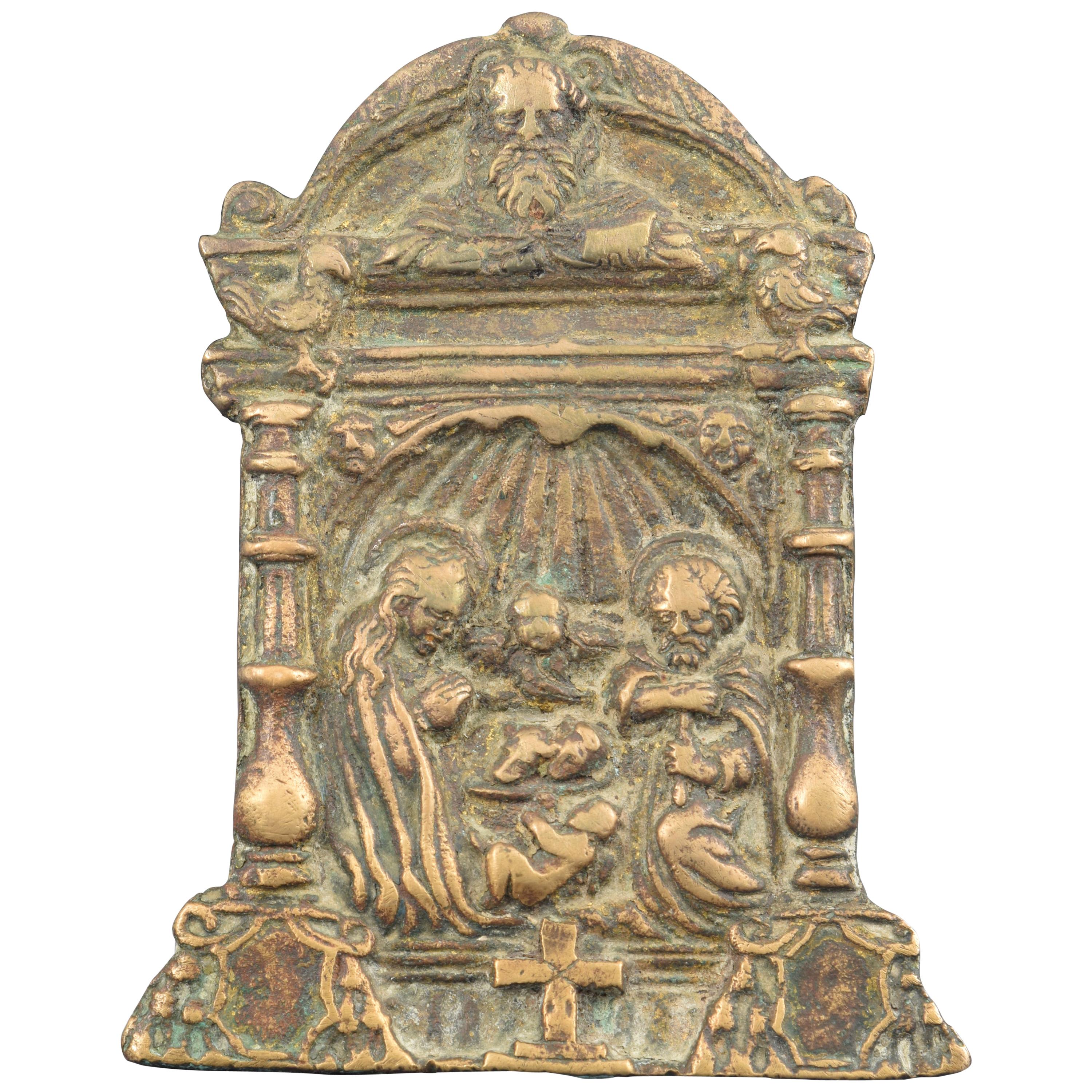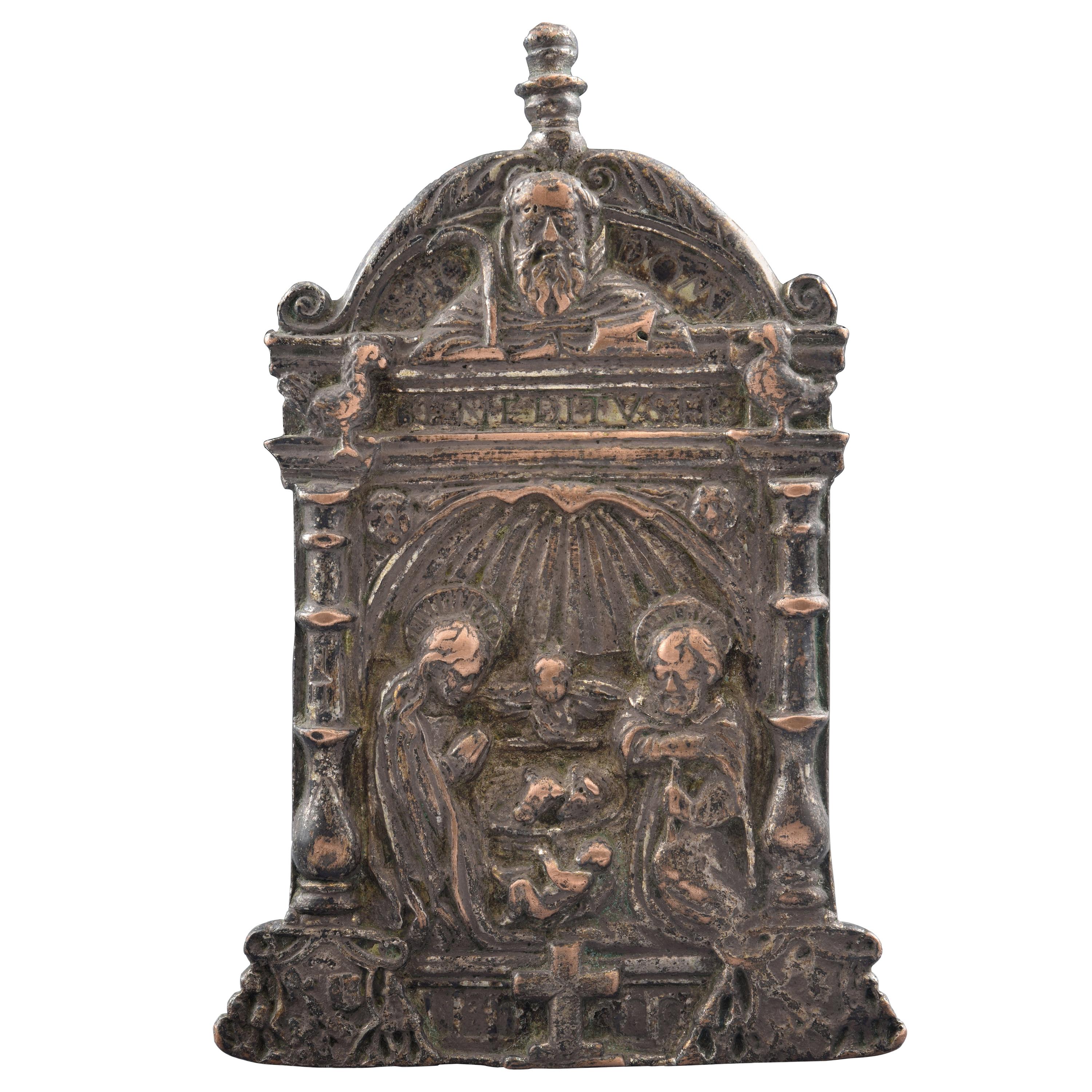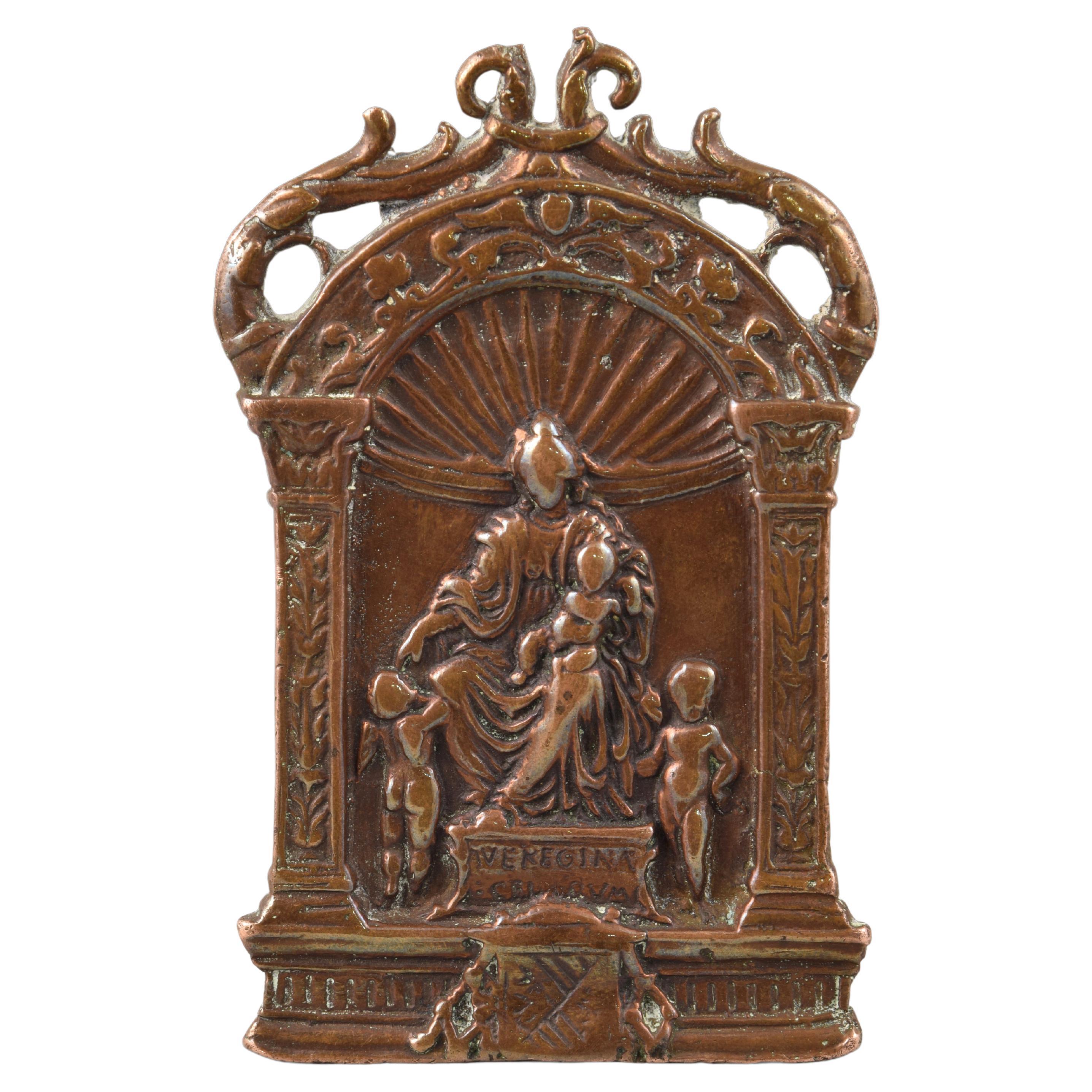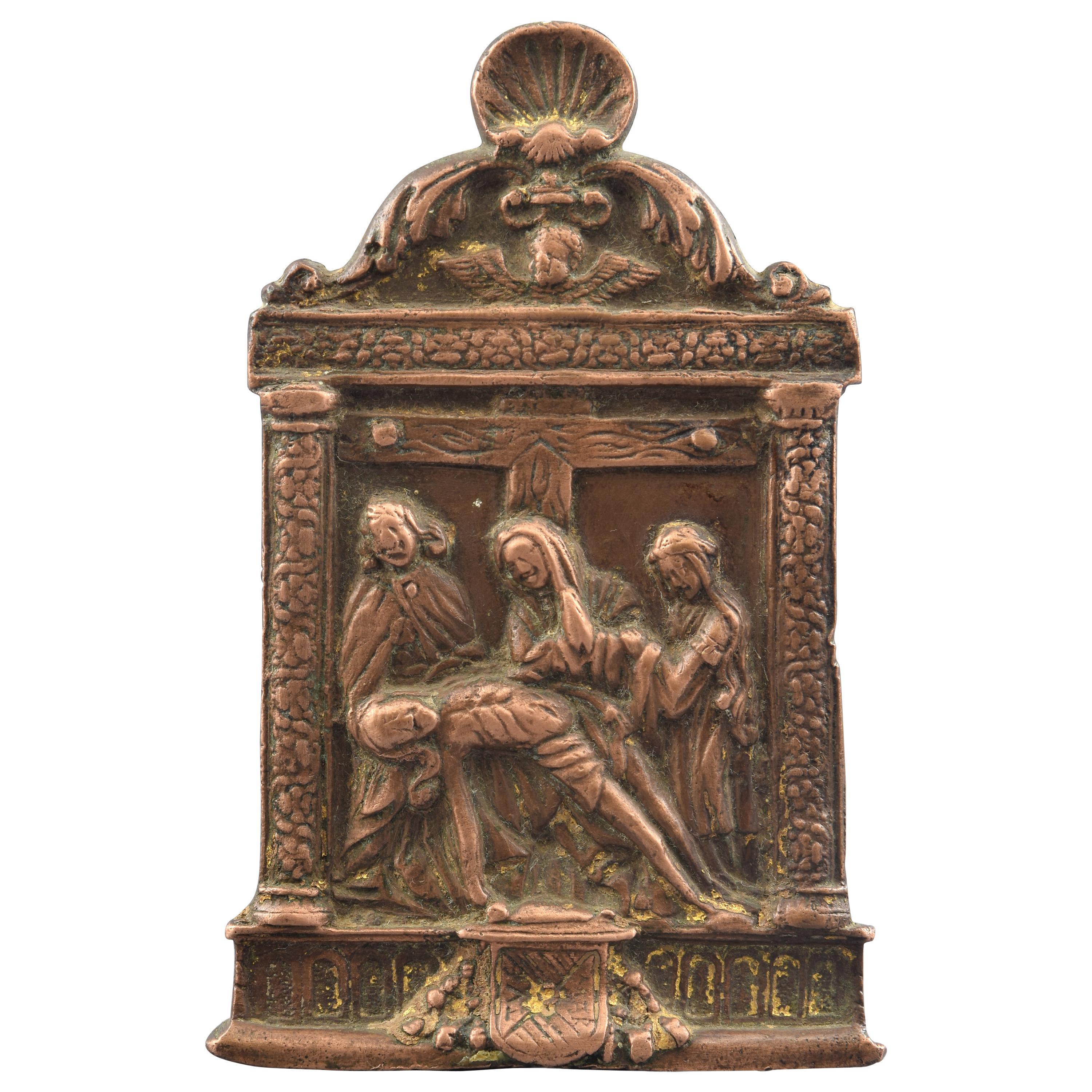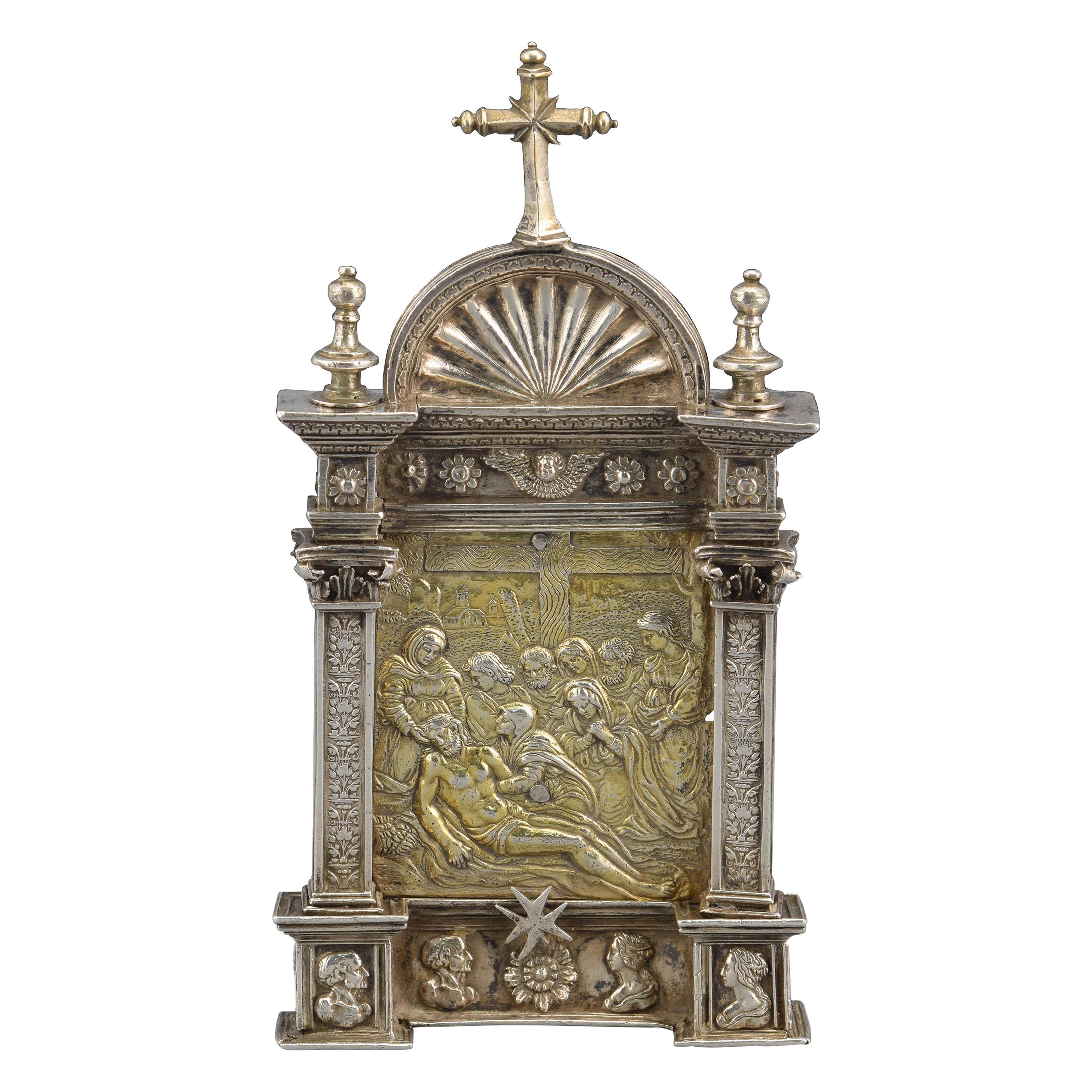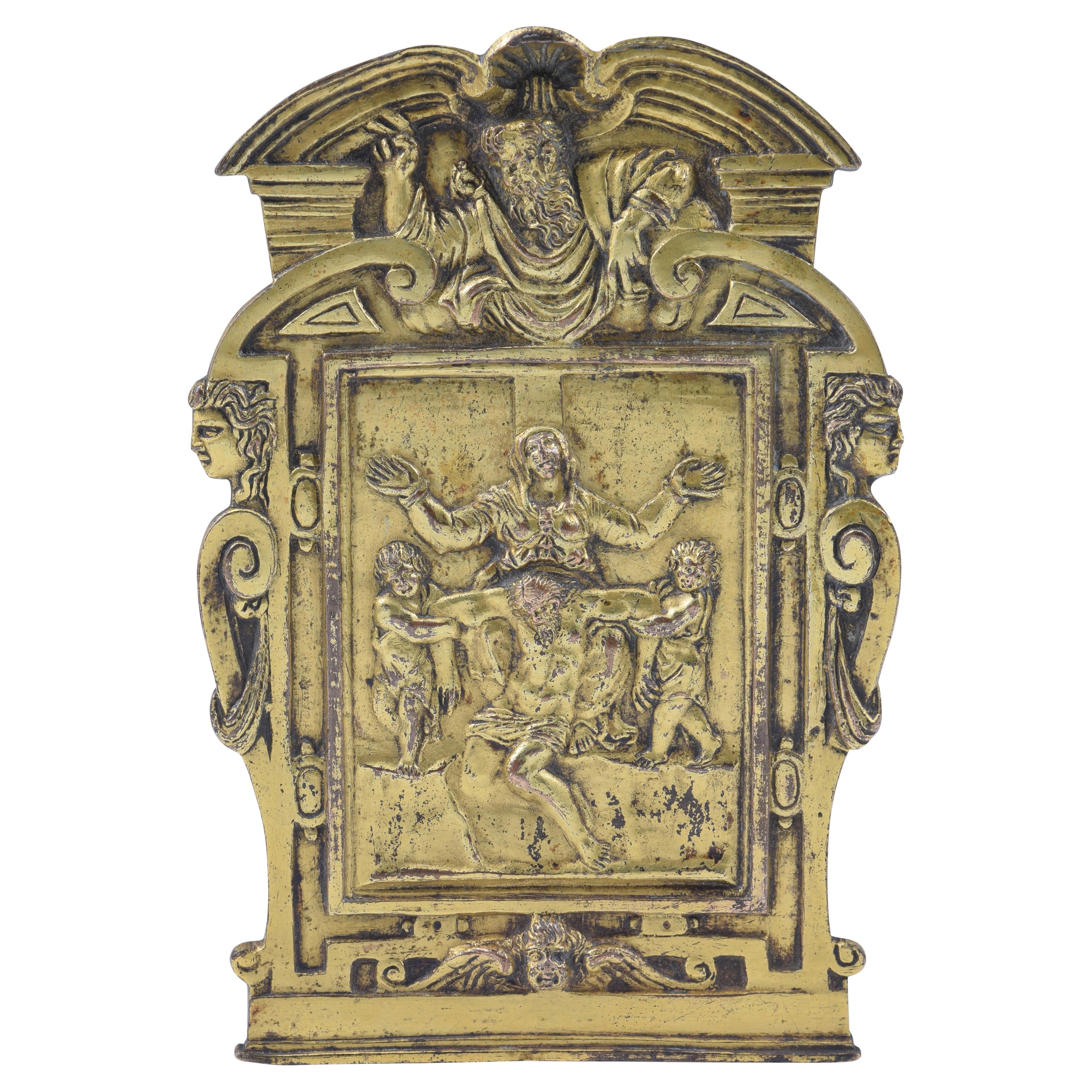Items Similar to Italian Liturgical Pax Brede Or Osculatorium From The 16th Century
Want more images or videos?
Request additional images or videos from the seller
1 of 9
Italian Liturgical Pax Brede Or Osculatorium From The 16th Century
About the Item
Italy
16th century
A liturgical Pax Brede or Osculatorium. The carved wooden board “Kiss of Peace” representing Christ as a man of sorrows. The pax has the shape of an ancient temple. Christ is placed in a niche between four balusters. The upper pediment is decorated with a head with winged angles. At the back, we find the original handle.
With original polychrome painting
With the normal signs of use and age for a piece of about 500 years old!3750
- Dimensions:Height: 7.49 in (19 cm)Width: 5.16 in (13.1 cm)Depth: 3.27 in (8.3 cm)
- Style:Renaissance (Of the Period)
- Materials and Techniques:
- Place of Origin:
- Period:
- Date of Manufacture:Second half of the 16th century
- Condition:Wear consistent with age and use. With the normal signs of use and age.
- Seller Location:AMSTERDAM, NL
- Reference Number:1stDibs: LU6389238538242
About the Seller
5.0
Vetted Seller
These experienced sellers undergo a comprehensive evaluation by our team of in-house experts.
Established in 2017
1stDibs seller since 2022
Typical response time: 1 hour
- ShippingRetrieving quote...Ships From: AMSTERDAM, Netherlands
- Return PolicyA return for this item may be initiated within 3 days of delivery.
More From This SellerView All
- Dutch VOC Silver Shipwreck Treasure Coins From The Akerendam Shipwreck 1724Located in AMSTERDAM, NHOrigin: Holland Value: 2 pennies / 2 stuiver Date: 1724 A VOC Akerendam shipwreck treasure of nine 2 stuivers minted by the Province of Holland in 1724. The Akerendam sunk off th...Category
Antique 1720s Dutch Nautical Objects
MaterialsSilver
- Dutch Delftware Tobacco Jar with Brass Lid, 18th Century, StraatsburgBy DelftLocated in AMSTERDAM, NHA Dutch Delftware Tobacco jar with a brass lid. Origine: Delft, The Netherlands Date: Second half of the 18th century Workshop: Unknown A genuine blue and white tobacco jar...Category
Antique Late 18th Century Dutch Rococo Delft and Faience
MaterialsCeramic, Faience, Delft
- Spectacular Pair Large Round Tulip Vases or Tulipieres, 19th CenturyBy De Grieksche ALocated in AMSTERDAM, NHA pair of two Dutch Delft tulip vases or tulipieres The Netherlands 19th century A very large and decorative pair of two Dutch Delft tulip vases. Rou...Category
Antique Late 19th Century Dutch Baroque Vases
MaterialsCeramic, Faience
- Two plates with the Coat of Arms of the Webster Barony, 18th CenturyBy De Grieksche ALocated in AMSTERDAM, NHCity: Delft Workshop: De Grieksche A Owner: Jan Theunisz Dextra Date: 1758 - 1764 A set of twee beautiful and fine armorial plates with the coat of arms and dragon head crest o...Category
Antique 1760s Dutch Delft and Faience
MaterialsCeramic, Faience
- Blue and White Dutch Delft Tile: The Carrying of the Cross, 18th CenturyLocated in AMSTERDAM, NHThe Netherlands Utrecht Circa 1775 – 1800 A fine manganese Dutch tile with a New Testament biblical decoration of the Carrying of the Cross, Luke 23 v 25: ”As the soldiers led him a...Category
Antique Mid-18th Century Dutch Baroque Delft and Faience
MaterialsCeramic, Faience, Majolica
- Rare Dutch Majolica Plate with Tulip, Early 17th CenturyLocated in AMSTERDAM, NHA rare Dutch Majolica plate with a decoration of a tulip. Northern Netherlands, probably made in the city of Rotterdam. Made 1620 - 1640 Dutch majo...Category
Antique Early 17th Century Dutch Renaissance Ceramics
MaterialsCeramic, Majolica
You May Also Like
- Bronze Pax or Pax Board, 16th CenturyLocated in Madrid, ESPaper holder bronze. 16th century. Portapaz made of bronze with a flat handle in "that" on the back that presents a decoration in light relief framed in an architectural composition of classic taste. Under the columns of the sides two heraldic shields are presented; the center shows a Birth of Christ under a winged dome with heads of winged angels in the corners; flanked by two birds, at the top and under a semicircular arch, is the bust of Saint Dominic...Category
Antique 16th Century Spanish Renaissance Religious Items
MaterialsBronze
- Bronze Pax or Pax Board, 16th CenturyLocated in Madrid, ESPaper holder bronze, 16th century. Bronze paper holder with a flat curved handle on the back that features a relief decoration organized in the front through an architectural composition with a classical influence usual in the Renaissance. Under the columns on the sides there are two heraldic shields (without bonnet, laces with tassels on three levels) with a Latin cross in the middle zone; the center shows a birth of Christ under a winged dome with heads of winged angels in the corners; at the top and under a semi-circular arch, the bust of Saint Dominic...Category
Antique 16th Century Spanish Renaissance Religious Items
MaterialsBronze
- Bronze Pax or Pax Board, 16th CenturyLocated in Madrid, ESPeacekeeper. Bronze. Century XVI. Bronze purse with a handle on the back in the shape of an esse in the same material and a decoration in light relief on the front that shows, unde...Category
Antique 16th Century Spanish Renaissance Religious Items
MaterialsBronze
- Pax or Pax Board, Bronze, Spain, 16th CenturyLocated in Madrid, ESPaper holder bronze, 16th century. Portapaz made of bronze with an "asymmetric" handle on the back, which presents a decoration in light relief framed in an architectural compositio...Category
Antique 16th Century European Renaissance Religious Items
MaterialsBronze
- Silver Pax O Portapaz, Spain, 16th CenturyLocated in Madrid, ESPortapaz. Silver in its color and gilded. Century XVI. Portapaz made of silver that has a handle (decorated with delicate plant motifs similar to those of the pilasters) and a female and a male bust at the bottom, as well as other architectural elements on the back, and, on the front, an architectural composition classicist basement (with busts flanking a flower and a cross), two pilasters (vegetal decoration and capital recalling the composite order) with entablature (flowers flanking an angel's head; moldings), and a semicircular arch finish with elements veined in relief under cross and flanked by two architectural motifs in the upper part. This composition frames and enhances a gilt silver relief where you can see the Lament or Cry over the Body of Christ, with the Virgin holding the head of Jesus, Saint John at her side, the Magdalene and other characters, a cross following the group and a landscape background with houses and plant elements. This architectural structure mentioned is similar to the one present in other 16th century portapaces, such as that of the Magdalena de Dos Hermanas parish (Hernando de Ballesteros el Mozo, around 1575); or that of the Galaroza parish (same author and date); or that of the portapaz of San Miguel de Jerez de los Caballeros (in some details); etc. As for the relief, it is possible to clearly see a strong Italian influence, and the similarity between it and important pieces such as the Portapaz known as “de Cisneros by Juan de Burgos (1493-1497; MuseoCatedralicio de Alcalá de Henares), as well as in paintings and reliefs. Also noteworthy are both the male and female busts in the lower area and the Maltese cross (or Saint John's) that appears in this area. This symbol was used since the 12th century as an insignia by the Knights Hospitallers of the Order of Saint John of Jerusalem, also known as the Order of Malta...Category
Antique 16th Century Spanish Renaissance Religious Items
MaterialsSilver
- Gilt bronze pax board, Pietà. 16th-17th centuries, after Michelangelo BuonarrotiLocated in Madrid, ESPeacekeeper, Mercy. Golden bronze. Possibly Rome, last third of the 16th century-first quarter of the 17th century, following the model of Michelangelo Buonarroti. Gilded bronze pla...Category
Antique Early 17th Century European Renaissance Religious Items
MaterialsOther, Bronze
